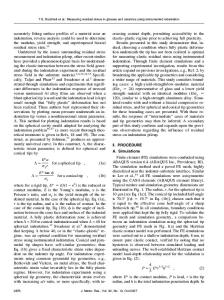Viscoelastic Characterization of Polymers Using Dynamic Instrumented Indentation
- PDF / 83,765 Bytes
- 6 Pages / 612 x 792 pts (letter) Page_size
- 29 Downloads / 509 Views
R5.3.1
Viscoelastic Characterization of Polymers Using Dynamic Instrumented Indentation C. C. White1, P. L. Drzal National Institute of Standards and Technology Gaithersburg, MD 20899-8615 M. R. VanLandingham Weapons & Materials Research Directorate, ATTN: AMSRD-ARL-WM-MA, Army Research Laboratory, Aberdeen Proving Ground, Maryland. Abstract Dynamic nanoindentation was performed on a poly(methyl methacrylate , PMMA), and two different poly(dimethyl siloxane, PDMS) samples having different crosslink densities. Comparison was made between dynamic nanoindentation and rheological instrumentation measurements in the glassy and rubbery plateau regions of polymeric materials. Excellent agreement between bulk rheological data and dynamic nanoindentation data was observed for the two glassy materials and the less compliant of the two PDMS samples. Results were divergent for the more compliant PDMS sample. Introduction Nanoindentation has the promise of delivering nano-scale spatial resolution to the rheological characterization of soft viscoelastic materials. For example recent commercial improvements in instrumented indentation or nanoindentation systems have resulted in improvements in quasi-static force sensitivity[1] and the advent of dynamic testing using harmonic force-displacement capabilities. [2] These developments have generated scientific interest characterizing the mechanical response of soft materials such as plastics, rubbers, gels and biological materials. These soft materials, described as viscoelastic, have the ability to contemporaneously store and dissipate applied mechanical energy making the transformation between the measured instrumental responses and actual sample properties more complicated than it is for more traditional materials such as metals or ceramics. Thus, these viscoelastic materials present a major challenge to the application and interpretation of nanoindentation. The development of instrumented indentation systems capable of applying ultralow forces with virtually identical control and detection systems to those used in commercial rheometer instrumentation permits viscoelastic characterization of suitable materials. There are several fundamental differences between the classical rheological characterization instruments and these new-instrumented indentation devices that have been described in detail elsewhere. [3] In summary they involve the ability to characterize the applied force and the assumptions required to transform the resulting instrumental feedback to the complex viscoelastic materials properties. The objective of this paper is to directly compare the results from both nanoindentation and classical rheology on samples in both the glassy and rubbery
1
Address all correspondence to this author; email: [email protected]
R5.3.2
regions. This should help explain the differences in reported property values between the nanoindenter and other classical rheological devices. Experimental2 Study materials used included a poly(methyl methacrylate) sample, and two poly(dimet
Data Loading...











